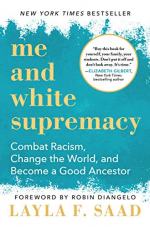
|
| Name: _________________________ | Period: ___________________ |
This test consists of 5 short answer questions, 10 short essay questions, and 1 (of 3) essay topics.
Short Answer Questions
1. Referring to a person by color is an example of which of the following?
2. In the book, the term “proponents” carries what meaning?
3. The term “microaggression” carries what meaning?
4. Which of the following movies does Saad identify as demonstrating white saviorism?
5. The term “cultural appreciation” carries what meaning?
Short Essay Questions
1. Saad makes particular mention of the hijab as an issue of white saviorism (206). Why might she have done so, based upon the materials included in the book?
2. What does Saad articulate as the primary differences between cultural appreciation and cultural appropriation?
3. What is meant in the book by “representation,” particularly as pertains to Viola Davis’s speech (123-25)?
4. Why, per Saad, is positive stereotyping harmful?
5. In moving into the second week of the work outlined in the book, Saad notes that biracial, multiracial, and white-passing persons of color are likely to experience particular discomfort in addressing the work of the week. What reason does she give for her statement?
6. Why, per Saad, is tokenism problematic?
7. Saad points out that personal mental health and behavioral issues are not necessarily justifications for not doing antiracist work. What reason/s does she give for the assertion?
8. What rhetorical appeal/s is / are made when Saad references Asam Ahmad in discussing being called in / called out (219-20)?
9. What rhetorical appeal/s is / are made when Saad discusses being invited to speak at a UK festival (210-12)?
10. What does Saad note is the purpose of the third week of the work outlined in the book?
Essay Topics
Write an essay for ONE of the following topics:
Essay Topic 1
At one point, the book uses the phrase that “you have bought it, hook, line, and sinker” (181). Between what things does the phrase make comparison? How does it do so? What problems inhere in the comparison? How do they do so?
Essay Topic 2
Saad notes that “white fragility looks like a white person taking the position of victim when it is in fact that white person who has committed or participated in acts of racial harm” (64). What advantage lies in taking the position of victim? What dangers associate with doing so? What effect is it likely to have? Why is it likely to have it?
Essay Topic 3
Saad suggests that relationships among white-privileged persons often, if not always, include reinforcement of white supremacy. What would a relationship among white-privileged persons look like absent the reinforcement of white supremacy? Why would it look that way? How do you know?
|
This section contains 937 words (approx. 4 pages at 300 words per page) |

|




